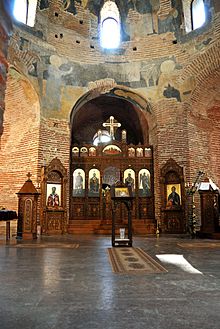Church of Saint George, Sofia
42°41′48.75″N 23°19′22.35″E / 42.6968750°N 23.3228750°E


The Church of Saint George (
The building, a cylindrical
History and architecture
The church is located in the courtyard between Hotel Balkan and the Presidency at a level a few metres below the modern streets of the capital. It is considered to be the oldest preserved building in the city, built at a time when Sofia was the residence of the emperors Galerius and Constantine the Great.
The church is part of a larger archaeological complex. Behind the apse, there are ancient ruins: a section of a Roman street with preserved drainage, foundations of a large basilica, probably a public building, and some smaller buildings. One of the buildings had been equipped with hypocaust and the tiles lifting the floor can be seen today. Experts define it as one of the most beautiful buildings in the so-called "Constantine district" of Serdika-Sredets, where the palace of Emperor Constantine the Great, and later of Sebastokrator Kaloyan were situated. Having survived the trials of time and having kept its appearance almost untouched, it is assumed that some of the most important meetings of the Council of Serdica had taken place in the church.
The Rotunda is a part of a large complex of ancient buildings from the late 3rd and early 4th century. It was built of red bricks and has a complex symmetry. At the centre, there is a domed rotunda room with a circular plan on a square base with semicircular niches in the corners. Since the 4th century, it has been used for christening (baptising) ceremonies. The dome rises to 13.70 m from the floor. Through the centuries it had been used as a public, religious and even a representative building.

There are five layers of partially preserved frescoes on the walls: the oldest is a Roman-Byzantine with floral motifs from the 4th century; the second in Bulgarian medieval style with angels from the 10th century; the third from the 11th and 12th centuries – a frieze with prophets and frescoes depicting the Ascension, Assumption, etc.; the fourth is from the 14th century with a donor's portrait of a bishop north of the entrance, and the fifth with Islamic ornamental motifs.
Outstanding among all the murals is the one from the 10th century, created most probably during the reign of the emperors

In the church, there were kept the holy relics of the patron saint of Bulgaria -
After a short stay in the capital
During the
Despite its small size, the church is similar to the
In exceptional occasions, the church is used as a setting for solemn military ceremonies and concerts with Orthodox and classical music.
See also
- List of churches in Sofia
- Saint George: Devotions, traditions and prayers
- Christianization of Bulgaria
- Bulgarian Orthodox Church
- List of oldest church buildings
- Ancient Roman architecture
- Rotunda (architecture)
- History of Roman and Byzantine domes
- Edict of Serdica
- History of Sofia
- Timeline of Sofia history
References
- ISBN 978-0-19-866277-8, retrieved 2020-06-12
- ^ "Rotonda Sveti Georgi". Archived from the original on 2014-05-20. Retrieved 2013-09-16.
External links
- (in Bulgarian) Gallery with pictures of the church and the ruins
- (in Bulgarian) Gallery with pictures of the frescoes of the church
- Богдан Филов, Софийската църква „Св. Георги“, София 1933 (преиздадена 2005).
